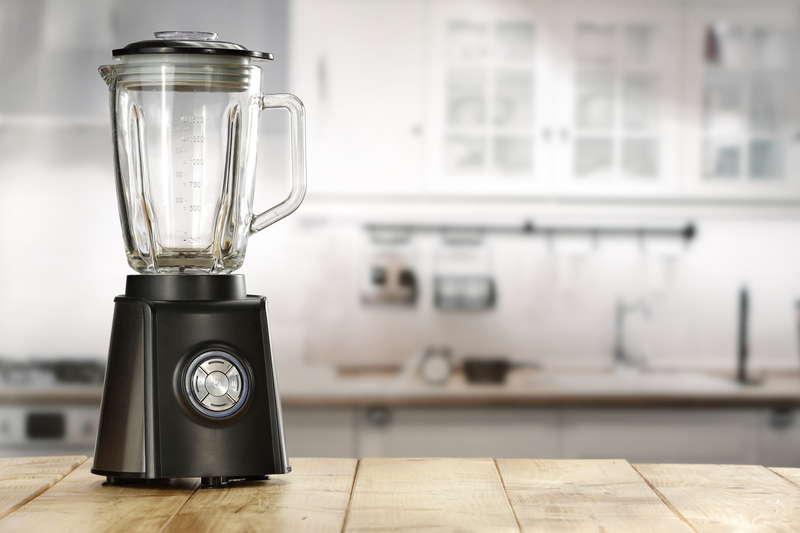The Ultimate Guide to Spotless Curtains
Posted on 10/06/2025
The Ultimate Guide to Spotless Curtains
Curtains not only add elegance and personality to your living spaces but also play a significant role in controlling light and maintaining privacy. However, over time, these beautiful fabric panels tend to attract dust, allergens, and stains, diminishing their appeal and hygiene. If you are determined to maintain spotless curtains in your home, this comprehensive guide will provide you with all the necessary tips, tricks, and strategies. Whether you have luxurious drapes, practical blinds, or delicate sheers, follow this ultimate curtain cleaning guide to keep every window treatment looking fresh and pristine all year round.
Why Spotless Curtains Matter
Many homeowners overlook the importance of curtain hygiene. Yet, curtains accumulate dust, pollen, pet hair, mildew, and unpleasant odors, all of which can trigger allergies and impact indoor air quality. Furthermore, spotless, well-maintained curtains elevate your home's appearance, provide a welcoming atmosphere, and even extend the life of your window coverings.
- Healthier living environment: Curtains collect airborne particles which, if not cleaned, can worsen allergies or respiratory conditions.
- Improved aesthetics: Clean curtains make rooms appear brighter, fresher, and well-cared for.
- Longer lifespan: Regular cleaning of curtains prevents premature fabric damage and fading.
- Odor control: Spotless curtains eliminate lingering smells from the kitchen, pets, or smoke.

Understanding Different Curtain Fabrics
Before adopting a cleaning routine, it's crucial to recognize the variety of curtain fabrics and their unique maintenance requirements. Here's a brief overview:
Common Curtain Fabrics
- Cotton: Durable and relatively easy to wash, cotton curtains are a popular choice for busy households.
- Linen: Offers a luxurious, breathable texture but is prone to wrinkling and may shrink in water.
- Silk: Exquisite and delicate; requires gentle care or professional cleaning to avoid damage.
- Velvet: Thick and luxurious, velvet needs careful maintenance to prevent crushing and fading.
- Polyester: Lightweight, easy-care, and resistant to wrinkles and shrinking.
- Sheer fabrics: Such as voile or lace, which are fragile and demand the gentlest cleaning methods.
Important: Always check the care label on your curtains before attempting any cleaning method. Fabrics may require dry-cleaning, hand-washing, or specialized treatments.
How Often Should You Clean Your Curtains?
One of the most common questions is how frequently you should clean your curtains for that spotless look. The answer depends on your living situation, fabric type, and environmental factors. Use the following guidelines:
- Every 3-6 months: Deep clean living room and bedroom curtains, especially if exposed to high traffic or sunlight.
- Monthly: Vacuum or dust window treatments to prevent buildup.
- Annually: For rarely-used or decorative drapes, a thorough yearly cleaning may suffice.
- As needed: Treat spills, stains, or odors immediately to maintain spotless curtains.
Routine Maintenance for Spotless Window Treatments
The Power of Regular Dusting
Dusting is the simplest way to ward off an accumulation of dirt and prevent stubborn stains. Try these options:
- Use a vacuum cleaner with an upholstery attachment to gently remove dust and allergens.
- A lint roller or microfiber cloth can help spot-clean dust or pet hair from curtain surfaces.
- Lightly shake or brush your curtains outdoors once a week to dislodge loose particles.
Effective Spot-Cleaning for Small Stains
For minor accidents, immediate spot-cleaning can save your curtains from long-term damage:
- Act quickly: Blot spills with a clean cloth--never rub, as it can spread or set the stain.
- Mild solutions: Use a mixture of lukewarm water and a drop of mild soap. Test on a hidden area first.
- Avoid harsh chemicals: They can damage or discolor delicate materials.
- Gently dab: Work from the outside of the stain toward the center to prevent spreading.
How to Deep Clean Curtains at Home
Eventually, every set of curtains will require more than surface dusting. Deep cleaning removes built-up grime and rejuvenates the fabric. Here are the most popular methods:
1. Machine Washing Curtains
- Check the care label to ensure machine-wash is suitable. Generally recommended for cotton, polyester, or blends.
- Remove hooks, rings, and detachable hardware.
- Shake curtains outside to eliminate loose dust.
- Wash with cool water on a gentle cycle using mild detergent.
- To prevent wrinkles and shrinkage, hang your curtains to dry rather than using a dryer.
- Pro tip: Iron on a low setting while slightly damp for crisp, spotless curtains.
2. Hand Washing Delicate Curtains
- Recommended for sheer fabrics, lace, silk, and embroidered or embellished curtains.
- Fill a large basin or bathtub with cool to lukewarm water and add a gentle detergent.
- Let curtains soak, then gently swirl with your hands. Avoid twisting or wringing the fabric.
- Rinse thoroughly with clean water until all soap is removed.
- Gently squeeze out excess water and hang to air dry.
3. Steam Cleaning Curtains for Maximum Freshness
- Steam cleaning is an excellent way to disinfect and refresh curtains without removing them from the rod.
- Use a garment steamer or appropriate steam-cleaner attachment, working from top to bottom.
- Keep the steamer moving to avoid water spots and fabric damage.
- Ideal for freshening up heavy or hard-to-remove curtains.
4. When to Choose Professional Curtain Cleaning
- For expensive, antique, or delicate curtains (like silk or velvet), professional cleaning ensures safe results.
- Seek specialists for blackout curtains, lined drapes, or curtains with complex pleating.
- Always tell cleaners about tough stains or possible fabric issues.
Tips for Drying and Rehanging Curtains
Proper drying is as important as cleaning to achieve truly spotless window treatments:
- Air-dry whenever possible: Hang curtains from a clothesline or shower rod in a breezy area.
- Flatten out creases: Reshape and stretch the fabric while damp to avoid wrinkles and shrinkage.
- Avoid tumble-drying: High heat can damage fibers and cause shrinking.
- Clean hardware: Wash rings, hooks, and rods before rehanging to prevent transferring dirt onto clean curtains.
How to Remove Specific Curtain Stains
Each type of stain may require a tailored approach to achieve immaculate, spotless curtains:
Food and Beverage Stains
- Blot up any excess spill with a paper towel.
- Dab a mix of cold water and gentle detergent on the stain. Avoid hot water as it may set stains like coffee or red wine.
- If needed, apply a solution of vinegar and water for persistent marks.
Ink and Marker Stains
- Use rubbing alcohol on a cotton pad and gently blot the stain.
- Test first on an inconspicuous area to avoid discoloring the curtain.
Mildew and Mold Stains
- Sunlight can help kill mold spores; let the curtain dry outdoors if weather allows.
- Use a mix of water and a little white vinegar for affected areas.
- Don't use bleach unless the care label says it's safe, as it can weaken and discolor fabric.
Pet and Odor Removal
- Sprinkle baking soda onto the dry surface and let it sit before vacuuming.
- Wash or steam-clean curtains frequently if you have pets or smokers in the home.
Preventative Measures for Pristine Curtains
You can keep your curtains cleaner between washes by following some simple preventative steps:
- Keep windows closed during windy or pollen-heavy days.
- Install tie-backs or holdbacks to minimize contact with dirty hands or pets.
- Trim foliage near exterior windows to reduce dirt and insects.
- Avoid placing furniture too close to curtains to prevent dust transfer.
FAQs About Spotless Curtains
Can I use bleach on white curtains?
- Not always. Bleach can weaken certain natural fibers and cause yellowing. Only use non-chlorine bleach if the fabric's care tag allows.
How do I keep blackout curtains spotless?
- Blackout curtains often have a special coating that may not be machine-safe. Dust and vacuum regularly, and spot clean as necessary.
- If deep cleaning is needed, consult a professional service.
Is ironing necessary after washing?
- Ironing helps remove wrinkles for a crisp finish--choose the lowest possible temperature for delicate or synthetic fabrics.
- Alternatively, hang curtains while slightly damp to let gravity do the work.
Can I hang curtains back while still damp?
- Yes, but ensure there's adequate ventilation to avoid mildew. Hanging while damp also helps prevent wrinkles.
Eco-Friendly Curtain Cleaning Tips
Making your curtain care routine eco-friendly is both easy and effective:
- Opt for plant-based or biodegradable detergents.
- Utilize steam (which uses only water) to freshen curtains rather than harsh chemicals.
- Air-dry instead of using an energy-consuming dryer.
- Repurpose old curtains as reusable cleaning rags or for home projects.

When Should You Replace Your Curtains?
Even with the most diligent curtain cleaning routine, some curtains will eventually need to be replaced. Consider new curtains if you notice:
- Persistent stains or odors that professional cleaning can't remove.
- Severe fading, tears, or fabric thinning.
- Outdated styles that no longer match your decor.
- Loss of blackout or insulating properties in specialized curtains.
Conclusion: Enjoying Spotless Curtains All Year Round
Maintaining spotless curtains isn't just about keeping your house looking its best--it's about creating a healthy, comfortable living space that uplifts your mood each day. By understanding your curtain fabric, adopting regular cleaning habits, tackling stains promptly, and investing in occasional deep cleaning, you can enjoy pristine window treatments for years to come. Make these curtain care strategies part of your household routine and bask in the freshness, beauty, and hygiene that only truly spotless curtains can provide.
Looking for more tips on home cleaning and organizing? Explore our other guides to keep your entire home sparkling from top to bottom!





